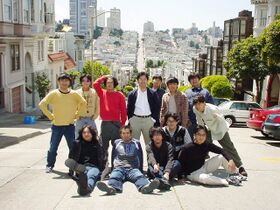Difference between revisions of "Sonic Team USA"
From Sega Retro
m (Text replacement - "{{Company |" to "{{CompanyBob |") |
m (→History) |
||
| (7 intermediate revisions by 2 users not shown) | |||
| Line 1: | Line 1: | ||
{{CompanyBob | {{CompanyBob | ||
| − | | logo= | + | | logo=Sonicteam.svg |
| − | | | + | | division=[[Sega of America]] |
| founded=1999 | | founded=1999 | ||
| defunct=2004 | | defunct=2004 | ||
| − | | | + | | headquarters=650 Townsend Street, Suite 650, San Francisco, California{{ref|https://web.archive.org/web/20000824043711/http://www.sonicteam.com/co_info/f_company.html}} |
| − | | | + | | nextdate=2004 |
| − | | | + | | next=[[Sega Studios USA]] |
| − | |||
}} | }} | ||
| + | {{sub-stub}} | ||
| + | '''Sonic Team USA''' was a division of [[Sega of America]] which was formed in 1999. The group came into being after members of the Japanese [[Sega Software R&D Dept. 8]] (trading as Sonic Team), led by [[Takashi Iizuka]], moved to San Francisco to help localise ''[[Sonic Adventure]]'' for the Western market. | ||
| + | |||
| + | ==History== | ||
| + | [[File:SonicTeamUSA SanFrancisco.jpeg|thumb|280px|Sonic Team USA staff]] | ||
| + | Sonic Team USA existed because [[Sega]]'s flagship video game franchise, ''Sonic the Hedgehog'' typically performs better outside of Japan. By developing games stateside (as was the case with ''[[Sonic the Hedgehog 2 (Mega Drive)|Sonic 2]]'' and ''[[Sonic 3]]''), it is easier to tailor ''Sonic'' products for Western markets. | ||
| + | |||
| + | ''Sonic Adventure'' was developed entirely in Japan, but as there were nine months between its Japanese and North American releases, a decision was made to go back, fix bugs, and change parts of the game based on local feedback. Consequently the Western versions of ''Sonic Adventure'' are more stable and polished than the original Japanese release, to the point where the game was re-released in Japan as ''Sonic Adventure International'' later in 1999. | ||
| + | |||
| + | Following the localised ''Sonic Adventure'', Iizuka's team chose to remain in the US and take the reigns on the game's sequel, ''[[Sonic Adventure 2]]''. For the next few years a relationship would form in which the Japanese Sonic Team and Sonic Team USA would work together, though given both sides were comprised of veteran Japanese ''Sonic'' developers, they were usually credited as one entity. ''Sonic Team'' producer [[Yuji Naka]] would oversee both halves of development and ultimately have the final say. | ||
| − | + | In 2004 the group changed its name to [[Sega Studios USA]]. | |
| − | |||
==Softography== | ==Softography== | ||
| − | + | {{CompanyHistoryAll|Sonic Team USA}} | |
| − | |||
| − | |||
| − | |||
| − | |||
| − | |||
| − | |||
| − | == | + | ==List of staff== |
| − | + | {{StaffList|Sonic Team USA}} | |
| − | == | + | ==Photographs== |
| − | + | :''Main article: [[:Category:Photos of {{PAGENAME}}|Photos of {{PAGENAME}}]] | |
==References== | ==References== | ||
<references /> | <references /> | ||
| − | {{ | + | {{SoAR&D}} |
Latest revision as of 20:04, 13 August 2022

| ||
| Sonic Team USA Division of Sega of America | ||
|---|---|---|
| Founded: 1999 | ||
| Defunct: 2004 | ||
Headquarters:
| ||
2004
|
This teeny-tiny article needs some work. You can help us by expanding it.
Sonic Team USA was a division of Sega of America which was formed in 1999. The group came into being after members of the Japanese Sega Software R&D Dept. 8 (trading as Sonic Team), led by Takashi Iizuka, moved to San Francisco to help localise Sonic Adventure for the Western market.
Contents
History
Sonic Team USA existed because Sega's flagship video game franchise, Sonic the Hedgehog typically performs better outside of Japan. By developing games stateside (as was the case with Sonic 2 and Sonic 3), it is easier to tailor Sonic products for Western markets.
Sonic Adventure was developed entirely in Japan, but as there were nine months between its Japanese and North American releases, a decision was made to go back, fix bugs, and change parts of the game based on local feedback. Consequently the Western versions of Sonic Adventure are more stable and polished than the original Japanese release, to the point where the game was re-released in Japan as Sonic Adventure International later in 1999.
Following the localised Sonic Adventure, Iizuka's team chose to remain in the US and take the reigns on the game's sequel, Sonic Adventure 2. For the next few years a relationship would form in which the Japanese Sonic Team and Sonic Team USA would work together, though given both sides were comprised of veteran Japanese Sonic developers, they were usually credited as one entity. Sonic Team producer Yuji Naka would oversee both halves of development and ultimately have the final say.
In 2004 the group changed its name to Sega Studios USA.
Softography
Dreamcast
- Sonic Adventure (1998)
- Sonic Adventure 2 (2001)
GameCube
- Sonic Adventure 2: Battle (2001)
Windows PC
- Sonic Heroes (2004)
List of staff
Photographs
- Main article: Photos of Sonic Team USA
References
- ↑ http://www.sonicteam.com/co_info/f_company.html (Wayback Machine: 2000-08-24 04:37)
| Timeline of Sega of America research and development divisions |
|---|
|
86
87
88
89
90
91
92
93
94
95
96
97
98
99
00
01
02
03
04
05
06
07
08
09
10
11
12
13
14
15
16
17
18
19
20
21
22
23
|
